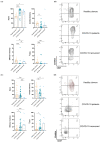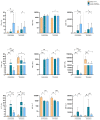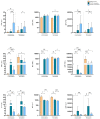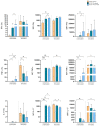Phenotypical and Functional Alteration of γδ T Lymphocytes in COVID-19 Patients: Reversal by Statins
- PMID: 36359845
- PMCID: PMC9656060
- DOI: 10.3390/cells11213449
Phenotypical and Functional Alteration of γδ T Lymphocytes in COVID-19 Patients: Reversal by Statins
Abstract
(1) Background: statins have been considered an attractive class of drugs in the pharmacological setting of COVID-19 due to their pleiotropic properties and their use correlates with decreased mortality in hospitalized COVID-19 patients. Furthermore, it is well known that statins, which block the mevalonate pathway, affect γδ T lymphocyte activation. As γδ T cells participate in the inflammatory process of COVID-19, we have investigated the therapeutical potential of statins as a tool to inhibit γδ T cell pro-inflammatory activities; (2) Methods: we harvested peripheral blood mononuclear cells (PBMCs) from COVID-19 patients with mild clinical manifestations, COVID-19 recovered patients, and healthy controls. We performed ex vivo flow cytometry analysis to study γδ T cell frequency, phenotype, and exhaustion status. PBMCs were treated with Atorvastatin followed by non-specific and specific stimulation, to evaluate the expression of pro-inflammatory cytokines; (3) Results: COVID-19 patients had a lower frequency of circulating Vδ2+ T lymphocytes but showed a pronounced pro-inflammatory profile, which was inhibited by in vitro treatment with statins; (4) Conclusions: the in vitro capacity of statins to inhibit Vδ2+ T lymphocytes in COVID-19 patients highlights a new potential biological function of these drugs and supports their therapeutical use in these patients.
Keywords: COVID-19; SARS-CoV-2 infection; mevalonate pathway; statin; γδ T cells.
Conflict of interest statement
The authors declare no conflict of interest.
Figures








Similar articles
-
[Characteristics of γδ T cell subsets induced from peripheral blood mononuclear cells of HIV/AIDS patients in vitro].Xi Bao Yu Fen Zi Mian Yi Xue Za Zhi. 2012 Mar;28(3):285-7. Xi Bao Yu Fen Zi Mian Yi Xue Za Zhi. 2012. PMID: 22394638 Chinese.
-
[Analysis of the numbers and subsets of MTB-HAg specific TNF-α+ γδ T cells in peripheral blood of patients with active pulmonary tuberculosis].Xi Bao Yu Fen Zi Mian Yi Xue Za Zhi. 2016 Nov;32(11):1527-1531. Xi Bao Yu Fen Zi Mian Yi Xue Za Zhi. 2016. PMID: 27774949 Chinese.
-
Human γδ T Cell Function Is Impaired Upon Mevalonate Pathway Inhibition.Immunology. 2025 Jul;175(3):300-322. doi: 10.1111/imm.13931. Epub 2025 Apr 22. Immunology. 2025. PMID: 40264329 Free PMC article.
-
Defying convention in the time of COVID-19: Insights into the role of γδ T cells.Front Immunol. 2022 Aug 11;13:819574. doi: 10.3389/fimmu.2022.819574. eCollection 2022. Front Immunol. 2022. PMID: 36032159 Free PMC article. Review.
-
Gamma Delta T-Cell Based Cancer Immunotherapy: Past-Present-Future.Front Immunol. 2022 Jun 16;13:915837. doi: 10.3389/fimmu.2022.915837. eCollection 2022. Front Immunol. 2022. PMID: 35784326 Free PMC article. Review.
References
-
- Gupta A., Madhavan M.V., Poterucha T.J., DeFilippis E.M., Hennessey J.A., Redfors B., Eckhardt C., Bikdeli B., Platt J., Nalbandian A., et al. Association Between Antecedent Statin Use and Decreased Mortality in Hospitalized Patients with COVID-19. Res. Sq. 2021;12:1–9. doi: 10.1038/s41467-021-21553-1. - DOI - PMC - PubMed
-
- Ridker P.M., Danielson E., Fonseca F.A., Genest J., Gotto A.M., Jr., Kastelein J.J., Koenig W., Libby P., Lorenzatti A.J., MacFadyen J.G., et al. Rosuvastatin to prevent vascular events in men and women with elevated C-reactive protein. N. Engl. J. Med. 2008;359:2195–2207. doi: 10.1056/NEJMoa0807646. - DOI - PubMed
Publication types
MeSH terms
Substances
LinkOut - more resources
Full Text Sources
Medical
Research Materials
Miscellaneous

